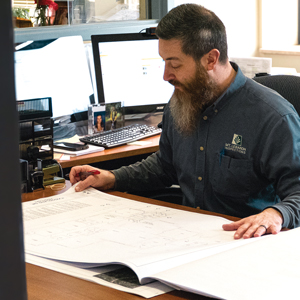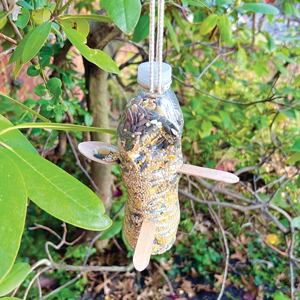Weathering the Storm

JUNE 20 All day long, everyone knew the storm was coming. It was just a question of when and how much. Around 7 p.m., a slow-moving storm cell lingered long enough to drop about 2 ½ inches of rain on Mt. Lebanon in an hour or so, and a total of 3 to 4 inches over the next three hours. Three inches of rain can put 20,000 gallons of water into a quarter-acre lot‚ just a little less than it would take to fill a 20-by-40-foot swimming pool with an average depth of five feet.
About an hour after the first wave, the calls began coming in. Over the next seven or eight hours, Mt. Lebanon firefighters and police officers would respond to a combined 67 storm-related calls. Over the next few days, public works employees and contractors would repair the most serious damage. Fixing the rest could take months.

First were the flooded basements. Cedar, Racine, Newburn, Twin Hills, a dozen other locations. Then a tree came down on North Meadowcroft, blocking the road and taking some power lines with it.
Shortly after that came a small electrical fire, also on North Meadowcroft, most likely as a result of the downed tree. So much for pumping out flooded basements.
“Naturally we divert our resources to the most critical event,” says Assistant Fire Chief Sean Daniels. “All our emergency responders were taxed to their limits.”
Police Lt. Paul Petras was the watch commander when the storm hit. He had four officers under his command.
“The first volley hit around 7, at the tail end of rush hour,” he says. “Had it come any earlier, there would have been lots more cars in it.
“The low-lying areas filled up fast. Castle Shannon, Cedar, parts of Beverly and McNeilly. Within 30 minutes, we were getting reports of vehicles having trouble getting through. One of our officers did a vehicle rescue on Cedar, and we couldn’t even get a tow truck into the area.”
Before the night was over, police and fire would rescue six people in three incidents, two on Cedar and one on McNeilly.
The rain stopped. The waters began to recede a little. Then around 8:30 came another downpour.
By this time the catch basins were blocked and water was shooting out where it was supposed to be going in. Manholes were blowing up.

Why Flooding Happens
Storm water is supposed to be absorbed into the ground or run off into catch basins that connect with the storm sewer system. But in a storm with the magnitude of the June 20 event, nothing goes as planned. Water floods people’s yards and basements, where it flows into the floor drains and overloads the sanitary sewer pipes that connect a property with the main sewer line in the middle of the street.
“It doesn’t take much (for) four-inch pipes coming from people’s basements to fill the eight-inch sewer main,” says municipal engineer Dan Deiseroth, president of Gateway Engineering.
When a major storm ends, the water eventually flows into catch basins or is absorbed into the ground, but it leaves behind damage to property, infrastructure and sometimes, people.
Mt. Lebanon storm sewers, most built in the 1920s and 1930s, were designed for 25-year storms, Deiseroth says—storms with a 4 percent chance of happening in any given year (as opposed to 100-year storms, with a 1 percent chance). That traditional way of categorizing storms is becoming a less reliable predictor, however, as events with the magnitude of June 20 have been coming with increasing frequency, and an overall upsurge in precipitation has made the ground less able to absorb rainwater. When asked how to categorize the June 20 storm, Chief Daniels answered, only half-joking, “the new normal.”
“[We’re seeing more] localized flooding where people can’t believe this much water came into their backyard,” says Deiseroth, a Mt. Lebanon resident.

Damage Control
It may be hard to believe if you spent days cleaning up a mess or arguing with your insurance company after a storm, but the damage could be much worse. Deiseroth credits Mt. Lebanon’s commitment to resolving storm water issues and upgrading sanitary sewer infrastructure over the past five or 10 years with lessening the impact of the storms.
Mt. Lebanon budgets $3.85 million annually for sanitary sewer improvements and $440,000 annually for storm water management. “It doesn’t prevent everything from happening, but it has prevented it from being bigger than it could be,” Deiseroth says.
This storm was big enough. The water washed sand layers from hilly brick streets such as Duquesne Drive and Hilf Street, leaving them less stable. Brick streets have a 7-inch concrete base with brick set in a 1 1/2-inch layer of sand. The water got underneath the bricks and flowed with such force that public works crews removed two full dump trucks of sand from the bottom of Hilf, and were well on their way to filling a third.
“I’ve never seen water flow like that before,” says Public Works Director Rudy Sukal. “It ripped out the pavement on Cedar Boulevard.
“It was a scramble to take care of the most important, higher priority issues first,” he says. “We had to close Cedar. Our top priority was to get it open as soon as possible.”
Because Mt. Lebanon declared a state of emergency the night of the storm, Sukal was able to get a contractor in the next day to repair Cedar Boulevard, bypassing the normal and sometimes lengthy public bidding process. Cedar reopened the day after it was closed.
The public works yard, which lies in a valley along Cedar Boulevard and is undergoing a multimillion dollar renovation, was at the center of the flooding. Water from high points on Washington, Bower Hill and Cochran Road all converge at that one point, Sukal says.
Contractors were working on the site, repairing 108-inch corrugated metal drainage pipes big enough to walk through, when the water hit. “The force of the water coming through folded the pipes on themselves,” Sukal says. The pipes ended up 80 percent blocked, so the contractors dug them up, leaving the open trench to accommodate more water flow.
“Fortunately, the storm moved north after that,” Sukal says.
As the second and third waves came, Petras decided to leave the public safety center and set up a mobile command post in a patrol car at Salem Drive and Cedar Boulevard, where a number of drivers were experiencing trouble in the rising waters.
“We were redirecting traffic, trying to get cars towed, coordinating with the fire department, when we heard that a third wave was coming,” he says. He stationed two officers along Cedar Boulevard and detailed the other two to work with the fire department on rescues, blocking roads, clearing debris and still responding to the normal load of calls received in the course of a shift.
Learning Experience
Once people were safe, Petras shifted his focus to setting up barriers around the danger areas. He used social media to get the information out but still had to contend with the disaster tourists. “Some people are attracted to danger spots,” he says. “They often underestimate the power and the impact of the water, and at the same time they overestimate their driving abilities.”
One driver simply ignored a police officer, drove around the barrier on McNeilly and right into the area where a water rescue had taken place.
Daniels was dealing with the same thing—people who underestimated or didn’t understand the risks. “People were walking around in the water, some of them barefoot,” he says. “You don’t know what’s in that water … household chemicals, maybe some raw sewage.”
A swift water rescue team from the SHACOG (South Hills Area Council of Governments) technical rescue team was on call, but was not needed. Fortunately, there were no fatalities in Mt. Lebanon, but an Upper St. Clair woman lost her life when she abandoned her flooding car and attempted to walk home, and an extraordinary survival story took place in Bethel Park, where a young man was swept into a storm sewer and came out at the end of the pipe unharmed.

Mt. Lebanon firefighters Kris Siegert and Joe Gavita are members of the swift water rescue team, and were involved in the rescues. Also assisting were firefighters Larry Celender, who was trained in swift water rescue in his previous position as a Montgomery County firefighter, Kurt Christofel and Bob Fischer. Police officer Tom Rutowski was involved in both Cedar Boulevard rescues.
“I’m real proud of how our organizations responded,” says Daniels.
Petras agrees. “I believe we prevented several potential fatalities or rescue situations from happening,” he says.
Days later, municipal officials and staff were still responding to phone calls from residents who had questions, concerns and issues as a result of the storm. Though nothing can guarantee a completely dry and undamaged community in the wake of a ferocious storm, the event has helped the municipality focus on areas that may need future preventative attention and to prioritize how money should be budgeted and allocated.
Municipal manager Keith McGill
would like to thank residents for
their patience and cooperation.
“For every service or function the municipality provides we look for continuous improvement,” says Municipal Manager Keith McGill. “Large-scale disaster events of this magnitude provide us with the opportunity to conduct a post-event analysis to determine what we did well, how we can improve our response and what we can do to mitigate or reduce impacts in the future.”
“I’d like to commend our staff and volunteers, who can be counted on in situations such as this, to go well beyond the call of duty.”





